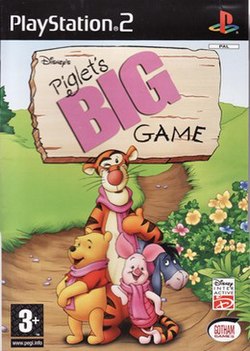| Piglet's Big Game | |
|---|---|
 PAL region PS2 cover art | |
| Developer | Doki Denki Studio [a] |
| Publisher | Gotham Games [b] |
| Director | Pascal Stradella |
| Series | Winnie the Pooh |
| Engine | RenderWare (GC, PS2) |
| Platforms | GameCube, PlayStation 2, Game Boy Advance, Windows, Mac |
| Release | GameCube PlayStation 2 Game Boy Advance |
| Genres |
|
| Mode | Single-player |
Disney's Piglet's Big Game (stylized as Piglet's Big Movie Game in North America) is a 2003 action-adventure game developed by French developer Doki Denki Studio. Intended towards younger audiences, the game is based on the Disney version of the Winnie the Pooh franchise. The game is loosely based on Piglet's Big Movie , and centers around Piglet and how he tries to overcome his fears.
Contents
- Gameplay
- GameCube, PlayStation 2, and GBA versions
- Microsoft Windows version
- Plot
- GameCube and PlayStation 2 versions
- Game Boy Advance version
- Microsoft Windows version 2
- Reception
- Legacy
- Notes
- References
- External links
The GameCube, PlayStation 2 and Game Boy Advance versions of the game feature seven levels which focus on Piglet entering his friends' dreams to help them with their problems. Enemies such as Heffalumps and Woozles can be encountered in certain locations and Piglet must pull a face to scare them away. The GameCube version received mixed or average reviews, while the Game Boy Advance version was given higher reviews; retrospective reviews of the GameCube and PlayStation 2 versions have been more positive. A separate Windows game was also released, which was a point-and-click adventure game in which Piglet helps Rabbit make soup for their friends.
Years after the game's quiet initial release, the GameCube and PlayStation 2 versions became a viral phenomenon online in 2024 when the game's music and gameplay were compared to the Resident Evil and Silent Hill franchises. Amid the newfound attention, the game's director Pascal Stradella confirmed that Resident Evil was an inspiration for the game. [5]